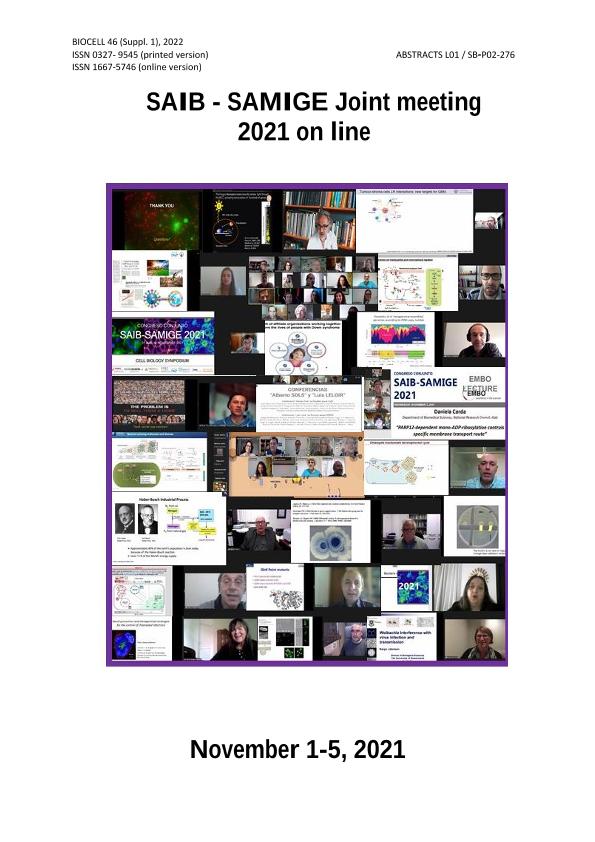Evento
Generation and Characterization of H. Volcanii Mutants en Genes with Predicted Roles in Motility and Electron Transfer
Tipo del evento:
Congreso
Nombre del evento:
Congreso Conjunto SAIB-SAIGE 2021. LVII Annual Meeting of the Argentine Society for Biochemistry and Molecular Biology Research (SAIB). XVI Annual Meeting of the Argentinean Society for General Microbiology (SAMIGE)
Fecha del evento:
01/11/2021
Institución Organizadora:
Sociedad Argentina de Investigaciones en Bioquímica y Biología Molecular;
Sociedad Argentina de Microbiología General;
Título de la revista:
Biocell
Editorial:
SAIB SAMIGE
ISSN:
0327-9545
e-ISSN:
1667-5746
Idioma:
Inglés
Clasificación temática:
Resumen
The halophilic archaeon Haloferax volcanii develops in a wide range of salinities (1.5-3.5 M NaCl) and, due to its ease of cultivation in the laboratory and the possibility of being genetically manipulated, it is used as a model organism for the study of archaeal biology. In the context of a comparative proteomics study of a rhomboid protease (RhoII) gene deletion mutant, we identified several proteins involved in metal homeostasis and cell surface structure/s assembly with differences in concentration and/or electrophoretic mobility in the protease deficient strain. Out of these, some were proteins which had not been previously characterized in H. volcanii, and that may constitute RhoII endogenous substrates. With the aim of understanding their physiological role, two of these annotated proteins (HVO_1153 and HVO_2150) were selected to generate and characterize the corresponding gene knock-out mutants. The hypothetical protein HVO_1153 primary sequence shows homology to adhesins and flagellins, and the hvo_2150 gene encodes HcpG, a predicted small copper protein (similar to plastocyanin and azurin) that may participate in electron transport and/or act as a copper reservoir in the cell membrane of H. volcanii. Genes were removed from the wild type chromosome by the ?pop-in / pop-out" method and the deletion in the null mutants was confirmed by PCR. The successful generation of the null mutant strains indicated that these genes are not essential for H. volcanii viability. The Δhvo_1153 mutant evidenced no differences in cell/colony morphology, cell adhesion to glass surfaces or growth in liquid medium at different conditions, when compared to the wild type strain. However, this mutant strain showed decreased motility in soft agar plates, in agreement with its predicted function in the databases. The ∆hcpGmutant did not exhibit deficiencies in growth in rich or minimal medium, when compared with the wild strain. Further phenotypic characterization of H. volcanii ∆hcpG is still ongoing. Altogether, the results presented in this work provide information regarding the role of two proteins which had not been previously characterized in H. volcanii and contribute to the general understanding of haloarchaeal physiology. Funded by ANPCyT and UNMdP.
Palabras clave:
HALOFERAX
,
MUTANTS
,
MOTILITY
Archivos asociados
Licencia
Identificadores
Colecciones
Eventos(IIB)
Eventos de INSTITUTO DE INVESTIGACIONES BIOLOGICAS
Eventos de INSTITUTO DE INVESTIGACIONES BIOLOGICAS
Citación
Generation and Characterization of H. Volcanii Mutants en Genes with Predicted Roles in Motility and Electron Transfer; Congreso Conjunto SAIB-SAIGE 2021. LVII Annual Meeting of the Argentine Society for Biochemistry and Molecular Biology Research (SAIB). XVI Annual Meeting of the Argentinean Society for General Microbiology (SAMIGE); Argentina; 2021; 113-113
Compartir




